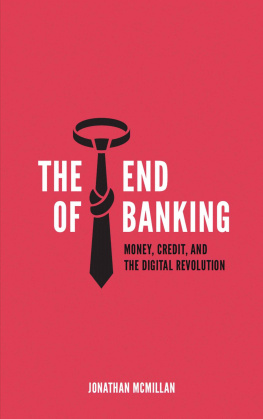
ADDITIONAL PRAISE FOR Virtual Banking
For too long financial services has lagged behind other industries in understanding and adapting to new consumer expectations of service. This book shows how they can stop falling behind by becoming part of the emerging new innovation eco-system' and adopting new ways of working, especially partnering with smaller innovative firms.
David Milligan, CEO, Matchi.biz
Virtual Banking is full of practical advice, built on careful analysis and thoughtful predictions, such as the future of mobile banking. A call-to- action for an industry that desperately needs deeper innovation-minded partnerships.
Michael Strange, CTO, Mitek Systems
Financial technology has advanced dramatically in the past two decades, but in recent years we've seen major banks and institutions embrace data processing technologies to be more efficient. In the 1990s, the limitations of mainframe technologies hampered the banking industry's ability to make automated decisions based on billions of data points. Today, parallel processing and scalable technologies have enabled an entire generation of alternative lenders, virtual banking products, emerging payment systems, and mobile tools for consumers, business owners, and the enterprise. Dan's book is a fantastic analysis of these evolutions and specifically how SMB's have become more inclined to use technology to grow fast.
Darian Shirazi, CEO and Co-founder, Radius
Founded in 1807, John Wiley & Sons is the oldest independent publishing company in the United States. With offices in North America, Europe, Australia and Asia, Wiley is globally committed to developing and marketing print and electronic products and services for our customers' professional and personal knowledge and understanding.
The Wiley Finance series contains books written specifically for finance and investment professionals as well as sophisticated individual investors and their financial advisors. Book topics range from portfolio management to e-commerce, risk management, financial engineering, valuation, and financial instrument analysis, as well as much more.
For a list of available titles, visit our web site at www.WileyFinance.com.
Cover image: Alex Belomlinsky/Getty Images
Cover design: Wiley
Copyright 2014 by Dan Schatt. All rights reserved.
Published by John Wiley & Sons, Inc., Hoboken, New Jersey.
Published simultaneously in Canada.
No part of this publication may be reproduced, stored in a retrieval system, or transmitted in any form or by any means, electronic, mechanical, photocopying, recording, scanning, or otherwise, except as permitted under Section 107 or 108 of the 1976 United States Copyright Act, without either the prior written permission of the Publisher, or authorization through payment of the appropriate per-copy fee to the Copyright Clearance Center, Inc., 222 Rosewood Drive, Danvers, MA 01923, (978) 750-8400, fax (978) 646-8600, or on the Web at www.copyright.com. Requests to the Publisher for permission should be addressed to the Permissions Department, John Wiley & Sons, Inc., 111 River Street, Hoboken, NJ 07030, (201) 748-6011, fax (201) 748-6008, or online at http://www.wiley.com/go/permissions.
Limit of Liability/Disclaimer of Warranty: While the publisher and author have used their best efforts in preparing this book, they make no representations or warranties with respect to the accuracy or completeness of the contents of this book and specifically disclaim any implied warranties of merchantability or fitness for a particular purpose. No warranty may be created or extended by sales representatives or written sales materials. The advice and strategies contained herein may not be suitable for your situation. You should consult with a professional where appropriate. Neither the publisher nor author shall be liable for any loss of profit or any other commercial damages, including but not limited to special, incidental, consequential, or other damages.
For general information on our other products and services or for technical support, please contact our Customer Care Department within the United States at (800) 762-2974, outside the United States at (317) 572-3993 or fax (317) 572-4002.
Wiley publishes in a variety of print and electronic formats and by print-on-demand. Some material included with standard print versions of this book may not be included in e-books or in print-on-demand. If this book refers to media such as a CD or DVD that is not included in the version you purchased, you may download this material at http://booksupport.wiley.com. For more information about Wiley products, visit www.wiley.com.
Library of Congress Cataloging-in-Publication Data:
ISBN 9781118742471 (Hardcover)
ISBN 9781118742549 (ePDF)
ISBN 9781118742365 (ePub)
To my wife Suzanfor agreeing to give me a tour of Bucharest
22 years ago and who remains just as charming, talented, and
beautiful 4 continents, 10 countries, and 2 kids later.
To Brianna and Demianwho regularly inspire me
with their own innovations and awesomeness
Foreword
By Renaud Laplanche
Co-Founder and CEO of Lending Club
When I founded Lending Club in 2006, I saw the potential for a new model to deliver credit, in a way that would transform the U.S. banking system into an online marketplace where investors directly fund borrowers, earning a return in the process and creating savings for borrowers. This transformation would allow the system to operate at a lower cost, be more transparent and more consumer friendly. As I started building Lending Club I came to learn from people like Dan that my vision was part of an unprecedented wave of technological innovations in financial services. The task Dan took onto provide a guide to such innovationsis enormously challenging, but as a former investment banker, industry analyst, and PayPal innovation executive, he was uniquely qualified to do so, and the result is a resounding success.
Todays financial services industry includes a plethora of technology companies, from new and innovative brokerage platforms like Stockpile, personal financial management platforms like Personal Capital and Wealthfront, new models for banking such as Simple, payments processors like Braintree, and business services such as Swipely. The common thread tying all of these innovations together is the customer-centric vision that brought them into being. Focusing on the consumer, rather than the product, as a starting point is one of the central themes of this book. Through its six chapters, Dan deftly outlines the landscape of the financial technology industry, acting as an accessible yet deeply thought-provoking tour guide to the rapidly changing financial technologies from mobile to social to Bitcoin.
Now more than ever customers demand immediacy, relevance, and personalization in their day-to-day behaviors. These trends are evident in the data and examples that Dan presents in the book. Consumers want to split checks with friends digitally at the restaurant (Venmo), request car service before getting onto the street (Uber), and access their Starbucks loyalty and payment card while waiting in line (Square). These trends will not only continue, but accelerate, as younger generations use their mobile phones for more transactions in their lives and are increasingly willing to share information and data with friends and financial institutions alike in order to get more customized service offerings.
Dan doesnt just describe the landscape at it exists today, he makes us consider the endless possibilities that tomorrow holds. What if your digital wallet not only pays for your purchase, but also automatically opts into your preferred method of getting rewarded, be it cash back or travel points, when you pay and redeem rewards? What if you received automatic budget alerts for spending on electronics when you either physically or virtually entered an Apple retail store? What if you never had to present your ID ever again to enter a bar or pay with your credit card? Dan invites us to imagine a world without friction, where banking is not an act or a destination but an enabler of everything that we do.
Next page










